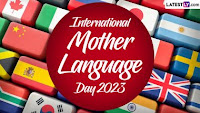 Yesterday was the 75th anniversary of the Communist coup that put the Czechoslovak Communist Party (KSČ) in power for 41 years until the Velvet Revolution.
Yesterday was the 75th anniversary of the Communist coup that put the Czechoslovak Communist Party (KSČ) in power for 41 years until the Velvet Revolution.
Here's a video I found out on YouTube about the coup.
An American expat adventure in Brno, Czech Republic.
 Yesterday was the 75th anniversary of the Communist coup that put the Czechoslovak Communist Party (KSČ) in power for 41 years until the Velvet Revolution.
Yesterday was the 75th anniversary of the Communist coup that put the Czechoslovak Communist Party (KSČ) in power for 41 years until the Velvet Revolution.
Here's a video I found out on YouTube about the coup.
 Česká televize recently decided on this year's entry for Eurovision. From 2 November to 8 December 2022, artists could submit their entry for 2023. There were 170 entries received and the field was narrowed down to five which were announced in January.
Česká televize recently decided on this year's entry for Eurovision. From 2 November to 8 December 2022, artists could submit their entry for 2023. There were 170 entries received and the field was narrowed down to five which were announced in January.
The rules were that solo artists had to have Czech citizenship. For group entires, the maximum number of members was six and at least one of the lead vocalists had to have Czech citizenship. This citizenship requirement was a Czech thing because there's no Eurovision rule that says a contestant must be a citizen of the country being represented. For example, Céline Dion won in 1988 competing form Switzerland even though she is Canadian.
This is the first year that the country will compete at Eurovision as Czechia instead of as Czech Republic. This is also the first time that Czech TV organised a live broadcast to determine who would be selected by audience vote. The vote was weighted as 70% for international voting and 30% by local Czech voting.
Here are the five entries that battled it out on TV.

 Up third was Markéta Irglová with her song Happy. She's from Valašské Meziříčí and has lived in Ireland, the USA, and now in Iceland. She won an Academy Award in 2008 for Best Original Song, Falling Slowly, for the film Once.
Up third was Markéta Irglová with her song Happy. She's from Valašské Meziříčí and has lived in Ireland, the USA, and now in Iceland. She won an Academy Award in 2008 for Best Original Song, Falling Slowly, for the film Once. Vesna performed fourth with their song My Sister's Crown. Three of the six members of the group are Czech, with a Bulgarian, a Slovak, and a Russian. Their song is about empowerment and pan-Slavic sisterhood with the lyrics in English, Czech, Ukrainian, and Bulgarian.
Vesna performed fourth with their song My Sister's Crown. Three of the six members of the group are Czech, with a Bulgarian, a Slovak, and a Russian. Their song is about empowerment and pan-Slavic sisterhood with the lyrics in English, Czech, Ukrainian, and Bulgarian.  The final performer was Rodan with his song Introvert Party Club. In 2021 he was nominated for Discovery of the Year 2021 and the music magazine Headliner included him amongst the 50 hopefuls of Czech music.
The final performer was Rodan with his song Introvert Party Club. In 2021 he was nominated for Discovery of the Year 2021 and the music magazine Headliner included him amongst the 50 hopefuls of Czech music. Today is International Mother Language Day. It was first announced in 1999 by UNESCO and it has been observed across the globe since 2000.
Today is International Mother Language Day. It was first announced in 1999 by UNESCO and it has been observed across the globe since 2000.
The goal is to support multilingualism and the use of mother tongues which allows one to better understand one's own identity. It also gives one a greater appreciation for cultural diversity.
I've had to adapt to British English since moving here to Euroland. So in honour of International Mother Language Day, here's a 5,5 minute video I found on YouTube that illustrates the American accents in each of the 50 states.
 Within the EU, there has been a greater push for consumer protection, especially between member countries whose own consumer protection laws may differ.
Within the EU, there has been a greater push for consumer protection, especially between member countries whose own consumer protection laws may differ.
Here's a short, English-language video from the European Commission that talks about five important consumer rights. However, the video is at least nine years old.
 On 6 January 2023, a new amendment to the Consumer Protection Act and the Civil Code came into effect. The Czech law was updated to be in synch with EU laws.
On 6 January 2023, a new amendment to the Consumer Protection Act and the Civil Code came into effect. The Czech law was updated to be in synch with EU laws.
 A few weeks ago I ordered a new router online from Datart but when it arrived I realised that I ordered the wrong thing. I immediately ordered the correct item but needed to take the wrong item back to the store. I thought that I needed to do this within 14 days but now that the law has changed I could have waited an extra two weeks before returning it. This was my first product return I've had since living in Czechland. It was simple enough. I took the router and the receipt to the store. They inspected the product and issued me a refund. I assumed that they would have just credited the credit card I used to make the purchase online but they gave me cash.
A few weeks ago I ordered a new router online from Datart but when it arrived I realised that I ordered the wrong thing. I immediately ordered the correct item but needed to take the wrong item back to the store. I thought that I needed to do this within 14 days but now that the law has changed I could have waited an extra two weeks before returning it. This was my first product return I've had since living in Czechland. It was simple enough. I took the router and the receipt to the store. They inspected the product and issued me a refund. I assumed that they would have just credited the credit card I used to make the purchase online but they gave me cash. Česka obchodní inspekce (ČOI) is the Czech Trade Inspection Authority (CTIA) and it falls under the jurisdiction of the Ministry of Industry and Trade. It's basically an enforcement agency.
Česka obchodní inspekce (ČOI) is the Czech Trade Inspection Authority (CTIA) and it falls under the jurisdiction of the Ministry of Industry and Trade. It's basically an enforcement agency.
The ČOI monitors and inspects both businesses and individuals who supply goods or sells goods and services in Czechland. It doesn't inspect the qualify of food as that is regulated by the Agriculture and Food Inspection Authority. However, it does regulate health and safety, storage, transport, and the sale of such products.
It can ban the sale of certain products in the country if they do not comply with Czech regulations.
For minor violations, ČOI inspectors may impose immediate fines of up to 5000 Kč ($230). For major violations, fines up to 50 million Kč (~$2.3 million) may be imposed.
 Ministerstvo průmyslu a obchodu is the Czech Ministry of Industry and Trade which was established in 1992. In short, the ministry is in charge of industry, energy and trade policy, business and investment promotion, internal trade and consumer protection.
Ministerstvo průmyslu a obchodu is the Czech Ministry of Industry and Trade which was established in 1992. In short, the ministry is in charge of industry, energy and trade policy, business and investment promotion, internal trade and consumer protection.
That's a pretty big purview. It also includes the use of European funds, the promotion of small and medium-sized companies, technical standardisation and quality control, industrial research, engineering and technology development, electronic communication and postal services, as well as being responsible for commodity exchange with the exception for issues under the Ministry of Agriculture.
Here's a short video, in English, that I found out on YouTube from the ministry highlighting Czechland.
 Datart is a consumer electronics store with shops across Czechia and Slovakia.
Datart is a consumer electronics store with shops across Czechia and Slovakia.
The company was founded in Prague in 1990 and they opened their first stone in 1992. In 2019 they opened the 100th store in Czechland.
This is the place to go for home appliances, computers, cameras, kitchenware, music systems, mobile phones, and accessories. If there's something that I need though I tend to order online.
I always had a problem with how to pronounce it. I first thought it was "Data-Art" but is it actually "Data-rt" or "Dat-art?"
 Back in 2017, they were acquired by HP Tronic Group for an undisclosed amount.
Back in 2017, they were acquired by HP Tronic Group for an undisclosed amount.
Here's a commercial for Datart that I found out on YouTube. It's at least a couple of years old.
 In a few weeks we're headed to Kuşadasi, Turkey. Or rather, I should get used to saying Türkiye. Either way I am so ready for a week away.
In a few weeks we're headed to Kuşadasi, Turkey. Or rather, I should get used to saying Türkiye. Either way I am so ready for a week away.
.png) I know that modern Türkiye came about after the end of WWI and the fall of the Ottoman Empire. What I didn't know was just how vast the Ottoman Empire was.
I know that modern Türkiye came about after the end of WWI and the fall of the Ottoman Empire. What I didn't know was just how vast the Ottoman Empire was.
Here's a short YouTube video about the rise of the Ottoman Empire.
But nothing lasts forever. Here's another short video but this one is about the decline of the empire.
The darkest legacy of the Ottoman Empire is the Armenian genocide where up to approximately 1,5 million Armenian Christians living in the empire were killed from spring 1915 through autumn 1916 . It is often called the first genocide of the 20th century and I still remember visiting the Armenian Genocide memorial in Yerevan.
Türkiye still denies that genocide occurred. However, the Catholic Church, the United Nations, the European Parliament, and the Council of Europe have all recognised it as genocide.
In 2017, the Czech Parliament approved a resolution condemning the Armenian genocide and in 2020 the Czech Senate unanimously adopted a resolution recognising the Armenian genocide.
In 2019, the U.S. Congress affirmed the Armenian genocide and the Senate unanimously recognised the genocide. Of course then-President Trump did not support the resolution but in 2021 President Biden officially recognised the Armenian genocide.
The Ottoman Empire made the fatal decision to side with the Central Powers in WWI. Here's a short four-minute video about why they chose to fight alongside Germany.
Following the end of the war, Mustafa Kemal Atatürk became the first president of the Republic of Turkey. Here's a bit about how the empire was carved up.
Considering that the Ottoman Empire contained parts of the Middle East, North Africa, the Caucasus and the Balkans, it's not a big surprise that there have been multiple conflicts between countries there since the breakup of the empire. This map shows the borders of the Ottoman Empire in 1801in green. The red lines show wars that have been fought between countries.
Fortunately, I'm not expecting any drama whilst on holiday in Kuşadasi. Fingers crossed.

Next month, we're off to Kuşadasi for a week and will visit Ephesus. I'll get to see what's left of the Temple of Artemis and will be the only item on the classic list I'll have seen.
 Strážnice is home to 5.400 people and is 65 km (40 miles) from Brno, close to the Slovak border. While Neolithic pottery has been found here, the it was first written mention of the town was in 1302. It was one of the most populated towns in Moravia at the start of the 17th century.
Strážnice is home to 5.400 people and is 65 km (40 miles) from Brno, close to the Slovak border. While Neolithic pottery has been found here, the it was first written mention of the town was in 1302. It was one of the most populated towns in Moravia at the start of the 17th century.
February isn't the time of year to see storks but here's a stork nest for when the season comes. I'm told that nearby is one of the last places in Central Europe where a forest colony of White Storks can still be seen.

The town hall is a protected cultural monument that dates back to the 17th century.



 Strážnice is also the home of really good potato chips (crisps).
Strážnice is also the home of really good potato chips (crisps).

Here's a short video I found on YouTube showing the factory and how the crisps are made.





